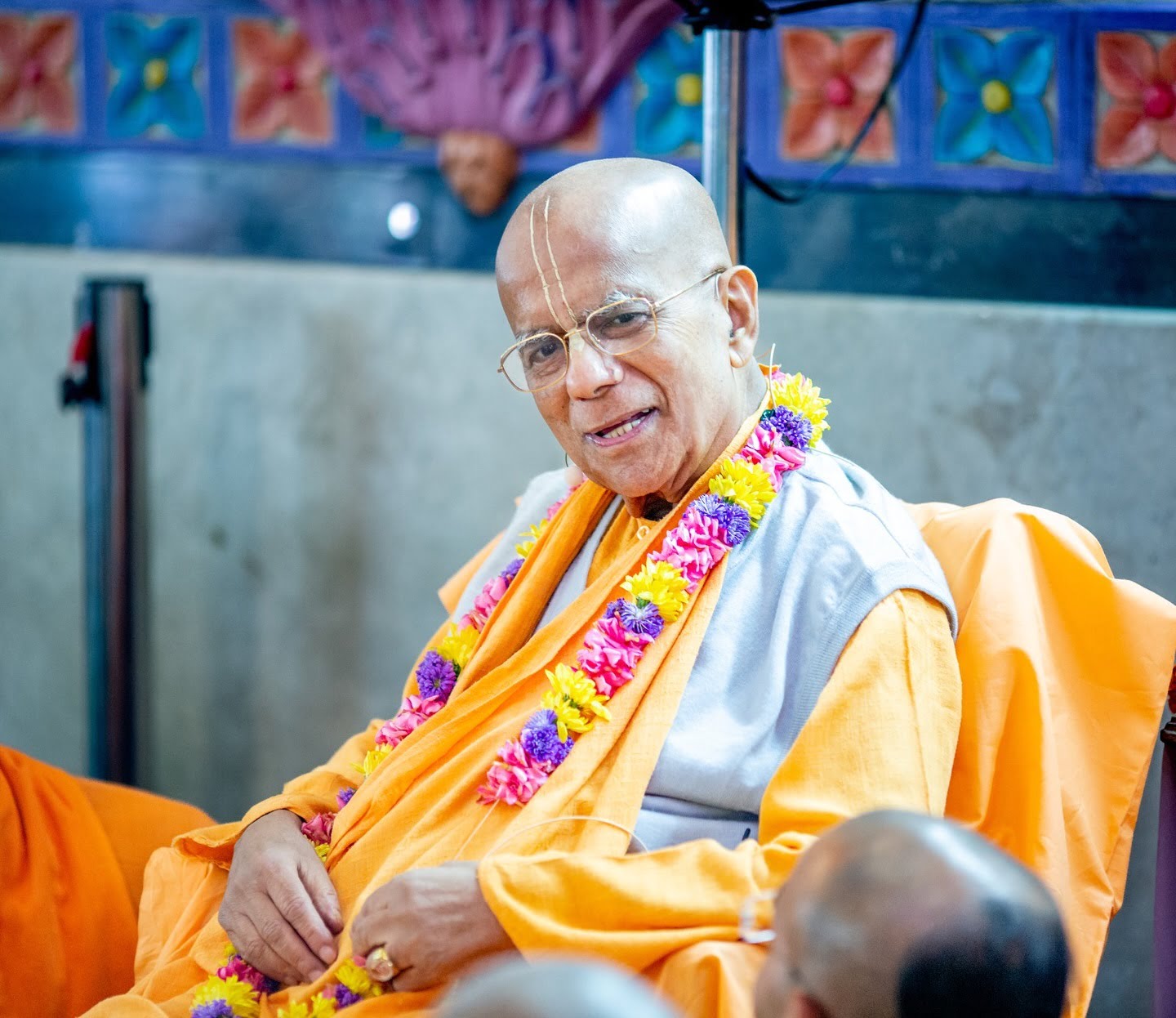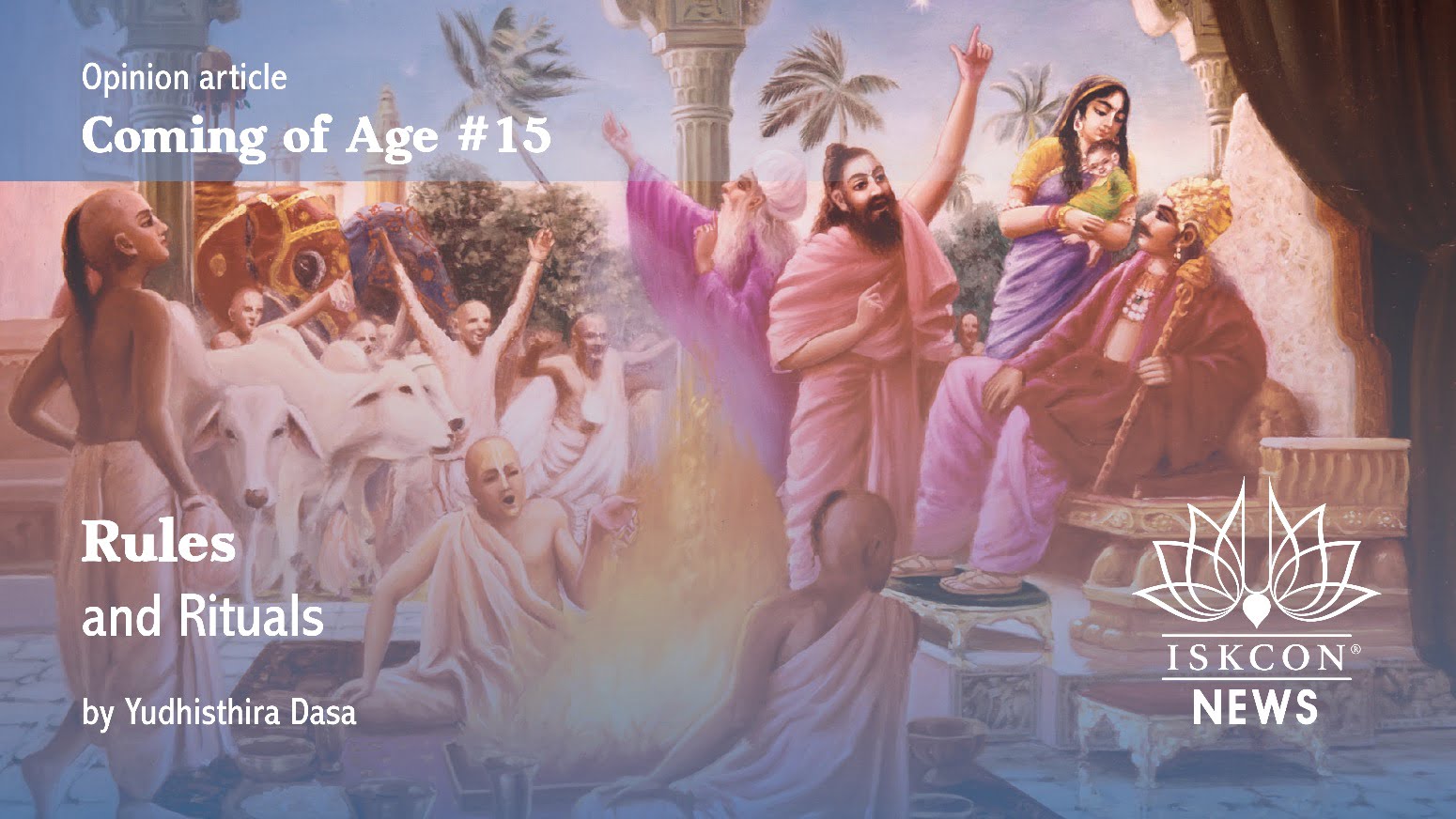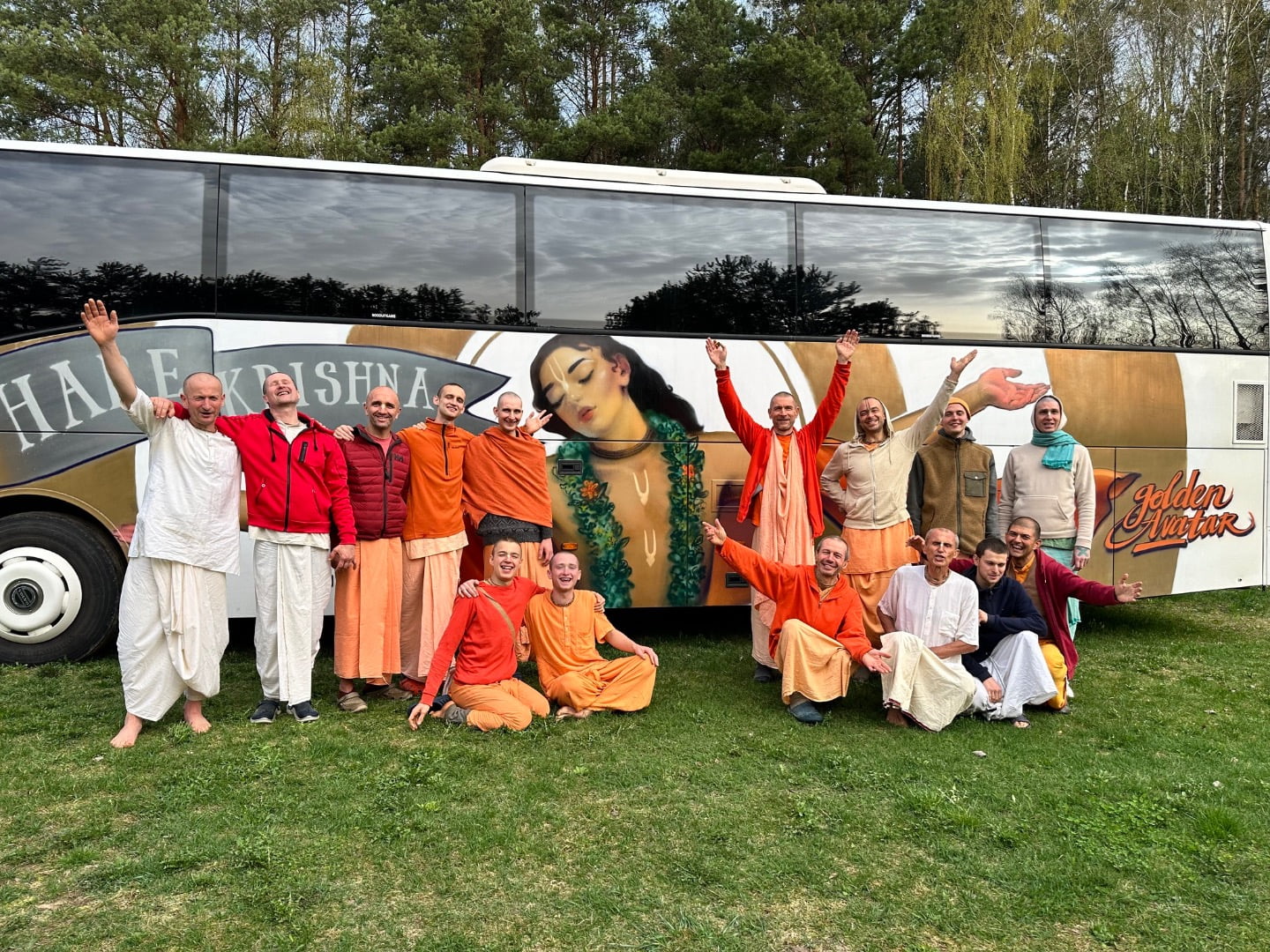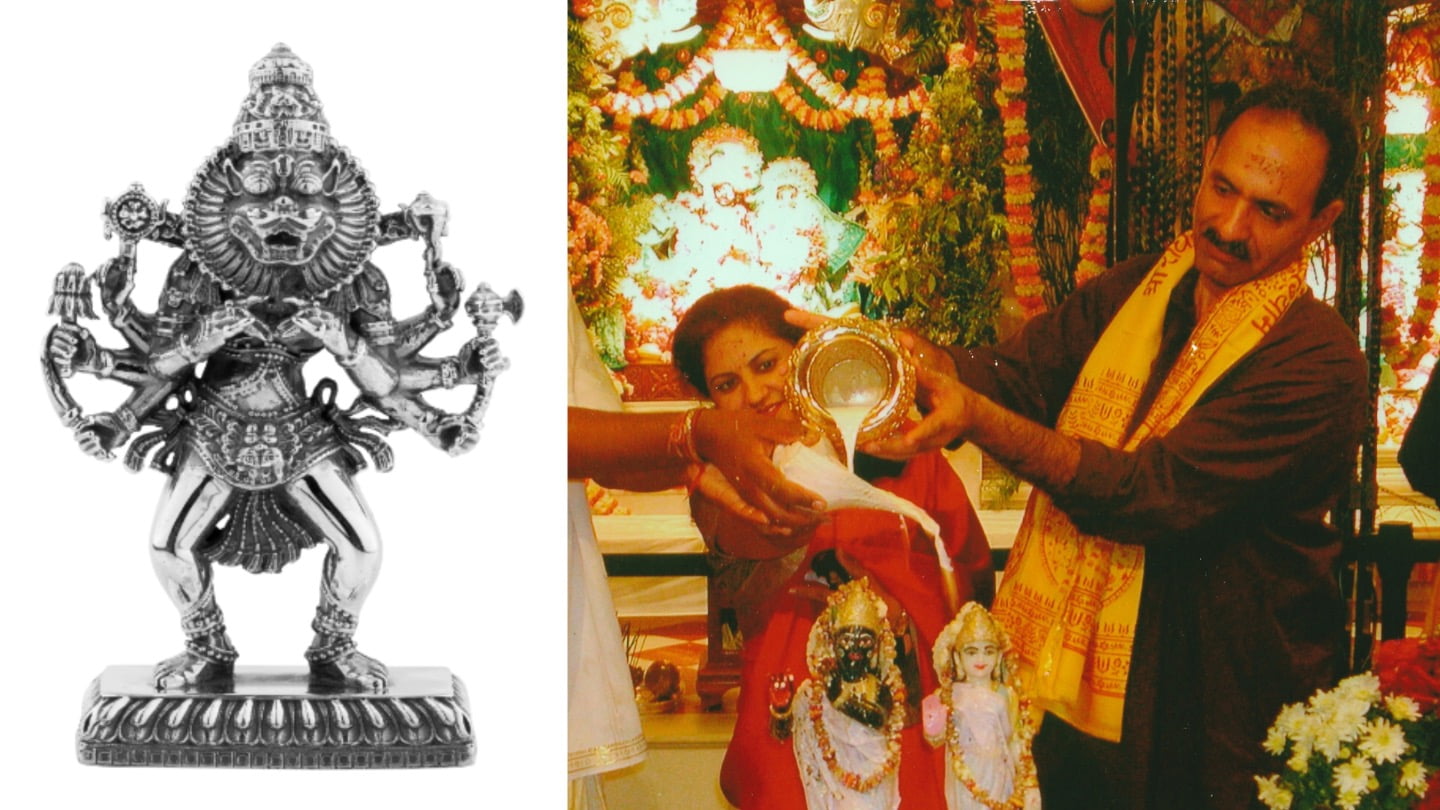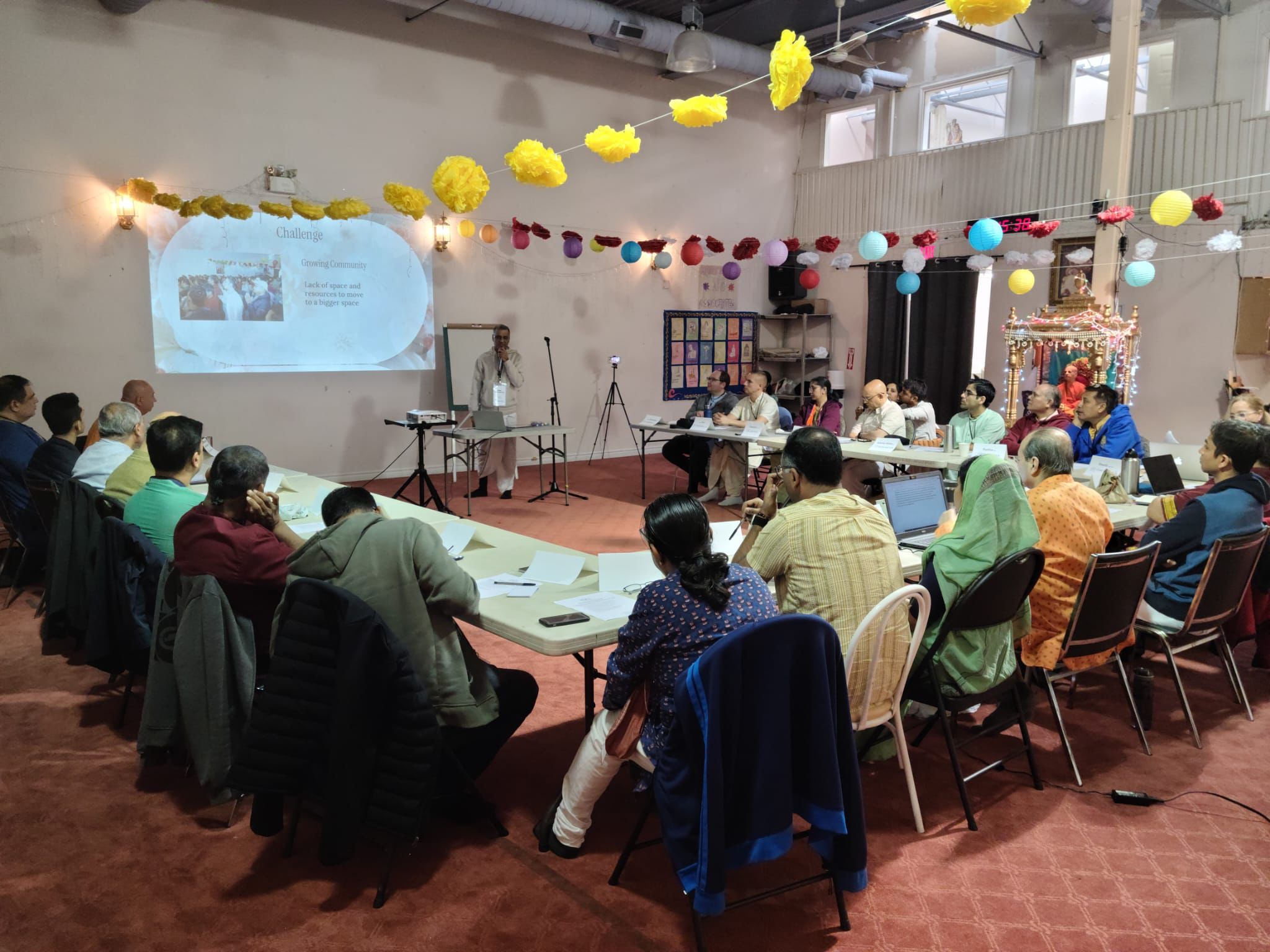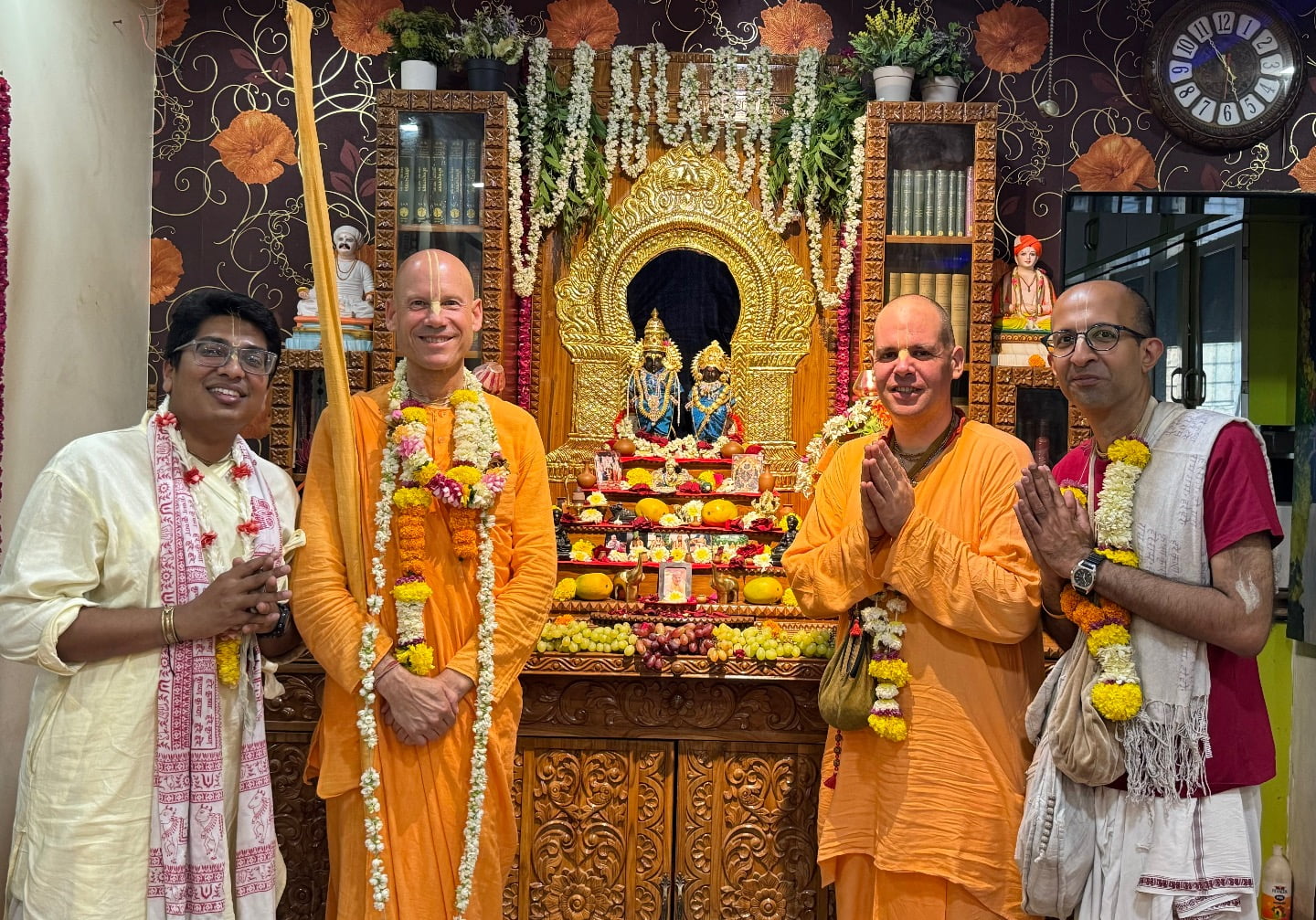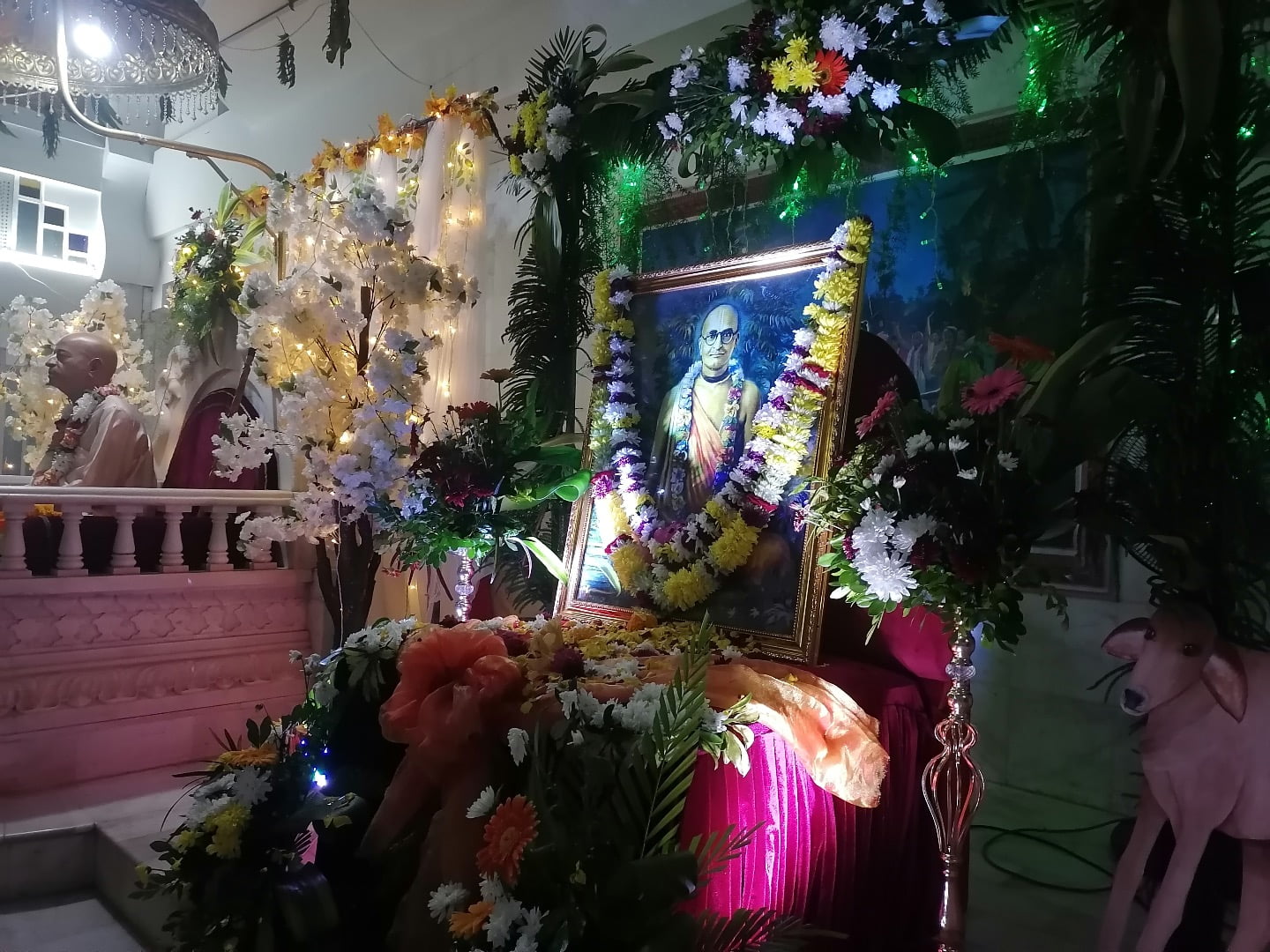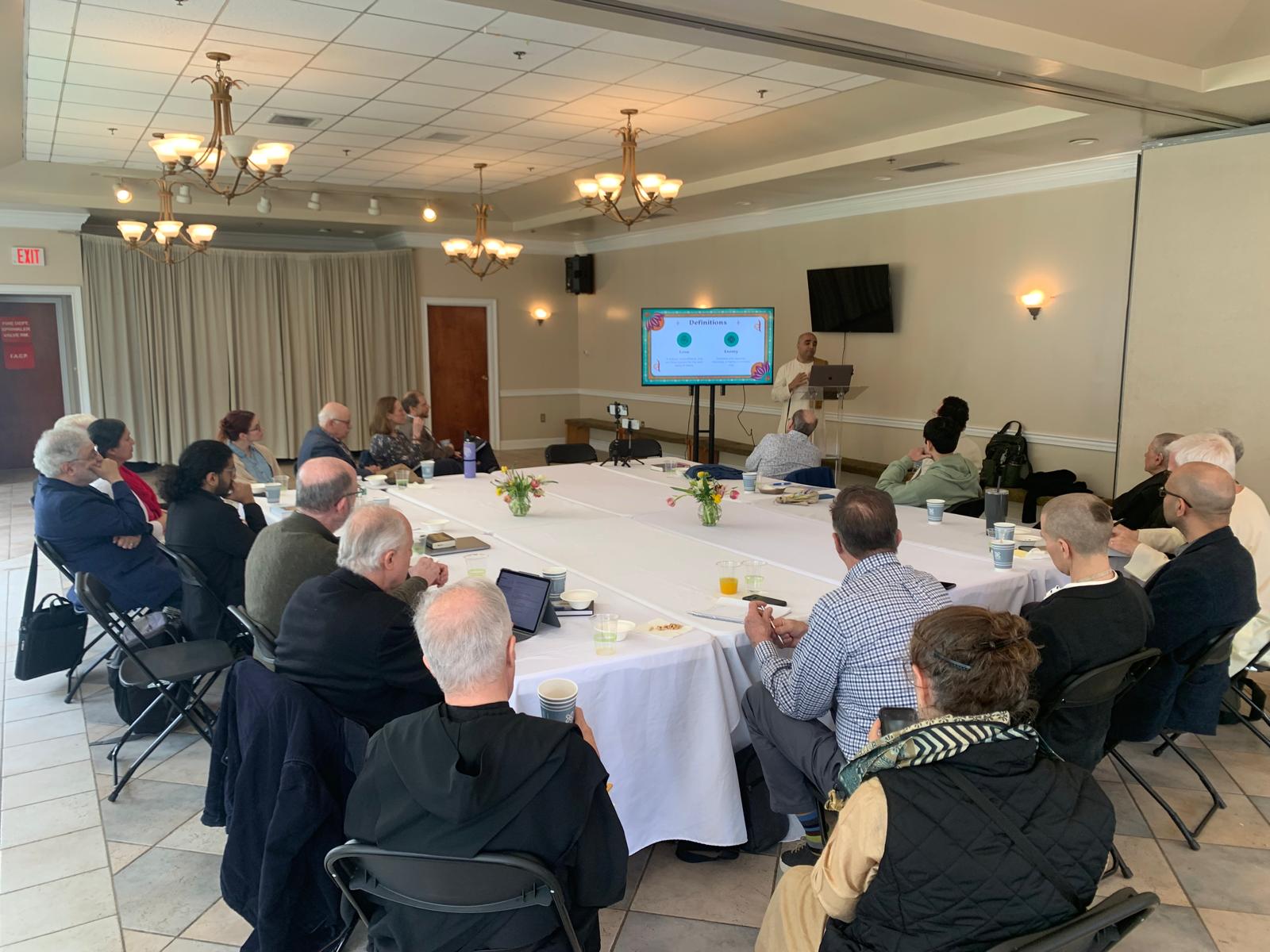A Theology with Heart: An Interview With Prof A. L. Basham
By Subhananda Das | Ноя 07, 2013
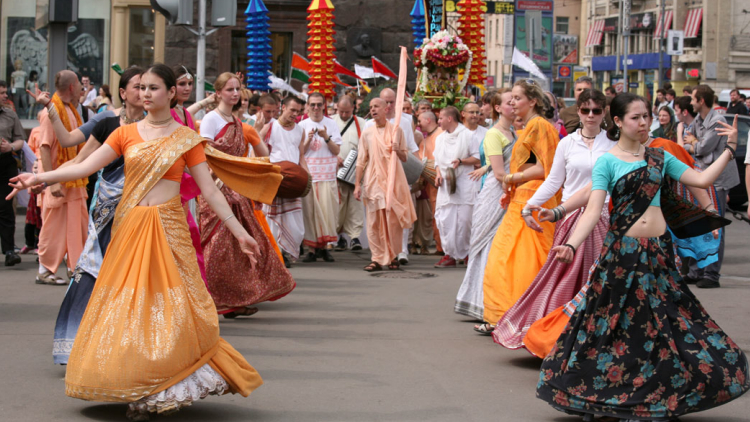
Professor A. L. Basham (1914-1986), one of the world’s most highly respected authorities on ancient Indian civilization, has written extensively on the Hindu and Buddhist religious traditions. He is best known, perhaps, for The Wonder That Was India, a widely used college text. The interview was conducted by Subhananda Dasa and published in the Back To Godhead Magazine in 1983. The full interview appears in Hare Krishna, Hare Krishna: Five Distinguished Scholars on the Krishna Movement in the West, a book published by Grove Press.
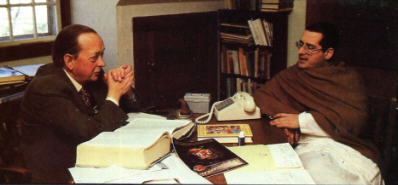
Dr. Basham and Subhananda Dasa (Steven J. Gelberg) during the interview in 1983
Subhananda dasa: In your conclusion to A Cultural History of India, you say that the Hare Krsna movement “is historically very significant, for now for the first time since the days of the Roman Empire an Asian religion is being openly practiced by people of Western origin in the streets of Western cities.” There are, of course, many religious groups of Asian origin that have established outposts in the West in one form or another. Why do you call special attention to the Hare Krsna movement?
Dr. Basham: For one thing, the Hare Krsna movement is very definitely a religion. It’s a religion which you have to believe in fully and completely. The numerous organizations in the past which have brought Indian ideas to the Western world organizations like the Ramakrishna Mission, the Theosophical Society, and so on while having certain religious characteristics, have essentially been societies of people interested in mysticism, gnosticism, and so on, mostly middle-aged people who met together once a week and listened to the local swami lecturing to them, and then went back and carried on with their conventional secular lives. But the Hare Krsna movement demands a significant change in one’s way of life if one is to become a full member of it.
As such, I don’t think anything like it has occurred in the European context since the days of the Roman Empire when Christianity, Judaism, Mithraism, and other religions made numerous converts in the West. It is, therefore, something not completely new, but something which, I think, hasn’t happened for a very long time indeed. And so I feel that it is very important historically.
You notice, I said in the streets of Western cities. We have, in fact, people of purely Western blood coming from families of the Christian or Jewish tradition who are doing, in the streets of Western cities, all the things and more which religious Hindus do in the streets of Calcutta. This being the case, I feel that without making any value judgments it is a very important historical phenomenon, and I can’t think of anything like it since the Roman Empire.
Subhananda dasa: In that same conclusion to A Cultural History of India, you write, “A new aspect of the counter-attack from the East is the importation not only of the mystical gnosis of India, but also of her simple faith. This is chiefly the work of the Hare Krishna movement founded by Srila Prabhupada.” What sorts of groups do you have in mind when you refer to the importation of “the mystical gnosis of India”? How is the Krsna consciousness movement different from these?
Dr. Basham: One can trace the steadily increasing influence of mystical gnosis in the Western world almost from the end of the eighteenth century onwards when the Бхагавад-гита was first translated into a European language by Charles Wilkins. Indian ideas circulated rapidly among the intelligentsia, not only in the English-speaking world, but also in other parts of Europe. They certainly had an effect on people throughout the Western world Germans like Schlegel, Deussen, and Schopenhauer, Americans like Emerson and Thoreau, Englishmen such as Max Mueller (an Englishman by adoption) and Aldous Huxley, Frenchmen like Romain Rolland, and Russians like Tolstoy. But these people were in no sense thoroughgoing Hindus, and they were impressed primarily by the mysticism of the Upanisads and of the Bhagavad-gita.
Since the Second World War, particularly, there has been a great increase in the number of practitioners and teachers of Indian mystical gnosis in the Western world. But these people have been essentially teachers of yoga, of mystical praxis, and of mystical ideas, but they have not been, in the same sense as in your Hare Krsna movement, religious leaders. Undoubtedly you do practice some form of meditation in the Hare Krsna movement, but your primary activity is not mysticism in that sense but singing the praises of Krsna. So this is a different thing. It is the simple Indian бхакти which you have brought into the Western world and not the mystical, otherworldly Upanisadic doctrines, which you may accept in theory but which do not mean so much to you as these simple, straightforward practices.
Subhananda dasa: But the бхакти tradition can also be accurately described as mystical and otherworldly, don’t you think? By “mystical” or “gnostic” I think you are referring specifically to Indian pantheism or monism, aren’t you?
Dr. Basham: Yes, that’s correct. Certainly бхакти tradition is mystical. It leads to transcendental experience. I myself have watched and you can almost say taken part in Caitanya kirtanas in Calcutta where one does feel complete release from all the toils and worries of the world and one is carried off into a higher sphere. It’s a wonderful experience and you feel better for it. This is a kind of mysticism; I’m not disputing it. But when I talk about the mystical gnosis of India I mean primarily the Advaita Vedanta of Sankara and his modern supporters and followers. This has come through in all sorts of ways with the Ramakrishna Mission and many smaller movements of one kind or another. But it isn’t quite the same thing as yours, which is essentially a matter of simple faith faith which is, of course, brilliantly articulated in a long-standing theological tradition.
Subhananda dasa: In a letter you recently sent me, you briefly contrast the Hare Krishna movement with the Vedanta of the neo-Hindu propagandists, whom you refer to as the “streamlined swamis.” What exactly do you mean?
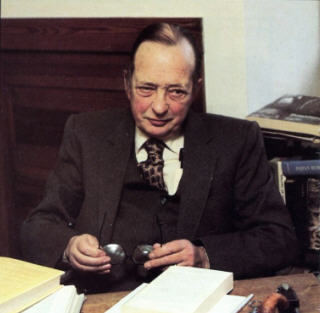
Dr. Basham
Dr. Basham: “Streamlined swamis” is a facetious phrase which I invented myself. I don’t mean it with any particular ill will, and I don’t wish to be unduly critical in the use of this term, but I intend it as a reference to the doctrines and teachings which various Indian swamis put forth, a streamlined kind of Hindu mysticism designed to appeal to modern, jet-age disciples: levitation in a few months or even weeks, moksa in a few easy lessons a Hinduism without class, without worship, without rigid taboos, and so forth. At the opposite extreme from your form of Indian religion or mysticism, we have, for example. Transcendental Meditation. TM seems to have dropped all its theological and even philosophical trappings. It’s just a method of mental and psychic training.
That is one extreme. Yours is the other. You appropriate an Indian religious sect its beliefs, its practices, all its taboos, and so on root and branch and import it into the West. In between these extremes we have all sorts of variations, and the “streamlined swamis” are those who tend rather to the Transcendental Meditation extreme than to yours. I don’t mean it with any undue disparagement, but such people do streamline their religious, theological, and philosophical ideas in order to make them palatable to the twentieth-century Western mind. That being the case, I think my phrase “streamlined swamis” is perhaps justified.
Subhananda dasa: So, as far as the other extreme the Krsna consciousness movement is concerned, you see its followers as pursuing more than merely Indian mystical ideas or meditational techniques. They venture upon a path of self-transformation, devoting themselves to a path that represents a clearly radical departure from normative Western thought, behavior, and lifestyle. In your view, then, what is it about Western or modern culture that they find so distasteful? Against what are they rebelling? On the other hand, what is it about Indian culture or Vaisnava бхакти tradition that they find so attractive?
Dr. Basham: I think one of the things that they subconsciously find difficult to get on with is the “permissive society,” the notion of “do your own thing”: concern yourself only with the fulfillment of your own personal whims and aims. You know the Hindu doctrine of the four progressive aims of life: dharma [social duty], artha [acquisition of wealth], kama [worldly enjoyment], and moksa [liberation] as the final end. The tendency of the permissive society is to leave dharma out altogether. And if you’re one of the “outsider” types who float around among the educated youth today quite a few of our students are like that you might also leave artha out. All you need bother about is kama. And that kama needn’t necessarily express itself in sexual activity. A lot of these kids seem to think that kama just means having sex, due to the phrase’ “Kama-sutra.” But obviously, in its broad context, kama means self-gratification: just do whatever you want to do, whatever you imagine is going to make you happy.
Subhananda dasa: As they say, “If it feels good, do it.”
Dr. Basham: Yes, if you think it’s going to benefit you and make you happy, then do it. That’s kama. And they find it just doesn’t work. They want something to map their courses by; they want something which gives them a feeling of direction. And, of course, dharma does that.
Psychologically, if we don’t follow our dharma whatever our dharma may be we’re sunk. As you realize, in the Hindu tradition, while there is sanatana-dharma [the eternal codes of right conduct, applying to everybody], everyone has also his own individual dharma, sva-dharma. We’ve got to follow our dharma or we suffer from all sorts of psychological difficulties, to say the least of it. It affects our karma [actions] and our overall behavior as well as our future happiness. And in this way whatever we believe about a future life there is a lot of truth in the fundamental doctrines of Hinduism.
Now, if people have no dharma, if they deliberately deny having a dharma, then their only dharma is just a vague sense of not bothering other people too much and getting on with “doing their own thing.” But everybody has a different “own thing.” They are no longer a group; they don’t really belong to anybody. They are isolated. Moreover, their life lacks direction. They drift. And for this reason, among others, we have a great growth in the use of dangerous drugs nowadays.
Sexual promiscuity or the permissive society may look all right on paper, but it has certain disadvantages which I think the world, more and more, is beginning to realize. For one thing, while the famous “pill” has largely solved the problem of unwanted children you can now use sex as a pleasant entertainment without any great fear of consequences it hasn’t solved the problem of human jealousy. A man and a woman are not going to be very happy in their relationship when they are constantly fearing that someday somebody might come along and take their partner away from them. This is what they are fearing today. I know from many of my students whom I’ve talked to especially it affects the women, but men feel it too. The thought of losing their beloved constantly haunts them. And it’s the same in marriage. A young married man has no real confidence in being able to keep his spouse until old age. And perhaps he himself will turn his eyes to another one. And thus the lack of stability in human relationships is one of the main causes of the growth of mental and psychological trouble in the world today.
Your movement sets itself diametrically against all this sort of thing. It disparages undue sexual activity. You musn’t have sexual activity unless you definitely want to produce a child. One man for one woman for the rest of your life. It goes back, in a very new and different guise, to eighteenth and nineteenth century Puritanism.
I might seem old-fashioned, but it seems to me that that is what the world needs. It may be that with the invention of easier and more reliable contraception, the world will never go back to anything quite like the old Puritanical conception of human relationships, but it needs something a bit like Puritanism . . . not necessarily the rigid Puritanism which would brand every person who committed adultery with an “A” on their forehead or, as the Muslims do in Saudi Arabia, execute them. It should be far more tolerant than that. At least some people feel that the world needs, and that they need, a system which has taboos about it.
We can’t all be grown-up all the time; only sannyasis and saints can do that. Many of us, for most of our lives, are children at heart, and we need some sort of guidance and control. A religious movement gives that. It is depressing that the Christian churches are doing very little in this respect now. Even the Catholics are getting almost as permissive as the unbelievers concerning their ideas of human relationships.
Not only does the young man or woman of this age, in many cases at least, find that the permissive society is unsatisfying, but he also finds the system of values which he is expected to follow unsatisfying.
On the one hand, he has the choice of one or another of the Christian communities, most of which still expect him to believe in certain doctrines he might find difficult to accept, such as the physical resurrection of Jesus. On the other hand, he has a downright unbelief, which is psychologically unsatisfying.
Man needs a sense of the mystery and the wonder of the world and of his existence within it. Unbelief or lack of concern for religion atheism, agnosticism, whatever you like to call it just doesn’t give that. An attitude of faith is really very important for human happiness: faith in something outside oneself, faith in the fundamental goodness of the world, or faith that there is good in the world and that the world has meaning. And if you can get that, you are at least some way on the road to a happier and better life.
I think that this is what attracts some people to the Krsna consciousness movement. The movement offers them a completely different lifestyle, one which is guided and directed. Within the framework of the movement they have a good deal of liberty, but it lays down guidelines which its members are expected to follow. Many young people really need direction, guidance, meaning.
Further, there is a general feeling, among many, that the capitalist society has made a mess of things. Communist society, which allows even less freedom than capitalism does, has also made a mess of things. Between them there is the danger of their blowing the world to bits. Many seek a third alternative, a different way of life which is neither one nor the other. Your movement presents them with an alternative which some, at least, find acceptable.
Subhananda dasa: Let me ask you to explain a little more about the two major and conflicting schools of Indian thought which you’ve been alluding to in our discussion: the devotional/theistic school versus the nondevotional/nontheistic school that is, Indian dualism (Dvaita) and Indian nondualism (Advaita), or what might be called the Personalistic versus Impersonalistic traditions. Do you have any suggestions perhaps from a psychological viewpoint, or perhaps from a sociology-of-knowledge perspective why people, in fact, become attracted to the monism of the Impersonalistic school? What are such people looking for? What sorts of needs may be satisfied by that particular philosophical viewpoint?
Dr. Basham: There are psychological influences at work. You see, this is an age of deep insecurity and fear fear of serious and terrible catastrophes in the world such as a Third World War, economic depression, severe depletion of natural resources, widespread social breakdown, disintegration of human moral values, and so on fears of all sorts and kinds which derive from the “acquisitive society” and the “permissive society.” And this deep insecurity and anxiety, in turn, help toward a feeling that you’ve got to negate or transcend your individuality, because if you’re no longer a personality, a self, you can’t suffer, because there’s no self to have consciousness of suffering. Moreover, the Advaita formula of “atman equals Brahman” [the individual soul is identical with the Supreme Soul] implies that you yourself are the whole universe and all that underlies it. But this is a refined form of egotism, if you like. It satisfies the individualist craving, and at the same time, by getting rid of the specific embodied individual, it gives the person hope that he will be saved from all the sufferings of finite selfhood.
Subhananda dasa: So there are two aspects, you’re saying, of the attraction to impersonalist thought. One is the fear of a spiritual personal identity, and the other is a kind of ultimate egotism a desire to become God.
Dr. Basham: Yes, that is how I see it.
Subhananda dasa: In his commentary on one verse of the Bhagavad-gita, Srila Prabhupada writes that those who have experienced the suffering of the world conclude that happiness can be experienced only when one is completely freed from personal identity per se, because it was as individual, personal selves that they experienced suffering.
Dr. Basham: Yes, they want to cut out their identity. If you’re not an individual, you can’t suffer. They want to get rid of themselves because they’re frightened of being a person. It’s a deep cosmic fear, a fear of the whole universe, the sort of thing that is reflected in some of the existentialist philosophers like Heidegger and Sartre.
Subhananda dasa: You seem to express a preference for the dualistic and theistic traditions. What is it about the great Vaisnava theologians like Ramanuja and Madhva that you find attractive?
Dr. Basham: I find their teachings more attractive because they leave room for personality in the universe: the personality of God and the personalities of individual souls who are God’s children and who are always sufficiently individualized to recognize themselves as being creatures of God. What the factual truth of the Ramanuja picture of the universe is, I don’t wish to discuss here. But it is certainly a much more attractive universe to me than the Sankara one; and for me it’s much more psychologically satisfying.
Subhananda dasa: Why?
Dr. Basham: Well, because the world obviously isn’t “one.” It may be all one within the body of God, contained in God. But I’m not you and you’re not me and I don’t see why when I achieve complete moksa (which I probably never shall in a thousand lives) I should be completely merged in you, and I don’t think I want to be. I don’t see logically why I should. I might become merged in God in that I feel that I’m almost one with God in devotion, and that I am within God, within the soul of God or that my soul is linked with God. But if I lose my individuality completely, I don’t see how I can enjoy the presence of God.
Subhananda dasa: Yes, that is our view also.
Dr. Basham: Well, these are all the arguments that go back to Ramanuja and his criticism of Sankara. And they are thoroughly valid. Sankara might have been more clever as a philosopher than Ramanuja, but in the final analysis I think that Ramanuja was a better philosopher.
Subhananda dasa: Theologically, our tradition is quite close to that of Ramanuja.
Dr. Basham: Yes, I know it is. If you follow Caitanya, you’re close to Ramanuja.
Subhananda dasa: You’ve put the Krsna consciousness movement within the broad historical context of theistic Hinduism, the бхакти tradition. More specifically, as you know, the movement is a direct modern expression of the devotional movement founded in sixteenth-century Bengal by the well-known mystic and saint Sri Caitanya.
In your Encyclopaedia Britannica article, “History of Hinduism,” you state, “With its discouragement of ritualism, its strong ethical emphasis, and its joyful expressive mood of worship, the Caitanya movement affected the whole life of Bengal and was not without influence in other parts of India.” With these or any other points in mind, what is most distinctive and important about Sri Caitanya’s movement within the overall context of India’s religious history?
Dr. Basham: There were, of course, other movements in other parts of India during the medieval period which are rather similar, but the Caitanya movement was, perhaps, most fully expressive of certain characteristics of these movements. It dispensed with the traditional, complicated brahminical yajna rituals, viewing them as unnecessary for salvation. As far as its “strong ethical emphasis” is concerned, it taught fellowship and brotherhood and the love of man for man with an intensity which many religious movements in India didn’t. It tended, thus, to override caste. We’re told that members of all castes were welcome in Caitanya’s order and that they lived together in perfect amity and unity. And, finally, the movement’s joyful and expressive method of worship: the kirtana with dancing through the streets of the towns and villages. If certain other Hindu sects do adopt this practice, I think they’ve done so under the influence of Caitanya. And all these things have tended to affect the whole life not only of Bengal but, to some extent, the rest of India.
Subhananda dasa: You mentioned earlier that you had taken part in a Caitanya kirtana in Calcutta. Can you describe that experience?
Dr. Basham: Over the years, I’ve observed several Caitanya kirtanas, but I remember one in particular. It was about twenty years ago. I got off a train in Sealdah Station, in Calcutta, just about sunset, and noticed that there was a Caitanya kirtanataking place in one corner of the station yard.
Whenever I come across a kirtana in progress, I always stop and listen, but often I’m in a hurry and have other things to do, and so I can only wait a minute or two. This time I was in no hurry. I had plenty of time to spare.
The devotees had erected a decorative tent in which they had set up the statue of Krsna and numerous brightly colored pictures of Krsna and Caitanya and the various saints of the order. The whole scene was lit up with bright lights and decorated with many flowers and various other decorations.
Not very many people were there at first, but as I stood watching and looking, more and more people came along and got involved. They were chanting “Hare Krsna, Hare Rama” just as you do. They kept on chanting and chanting and chanting, until, after a while, a few of them began to dance and then nearly everybody was dancing. I don’t think I got as far as dancing, but I found that I was certainly joining in the chanting and I was really carried away. I was there for at least two hours. It was a wonderful experience.
As I think you know, on a theoretical and logical level I am not able to fully accept your doctrine of the historicity of Krsna and so on, but nevertheless I do see the emotional and spiritual force of the Caitanya movement. That evening outside Sealdah Station is something which I will never forget the intense experience of exhilaration and relief, and the feeling of security and safety and inner happiness which came from it. And it was so clear that all the people were feeling it. It couldn’t but affect me too. The worshipers were mostly poor people or lower-middle class and better types of working-class people from the buildings and tenements of the surrounding neighborhood. They had, most of the time, very dull and difficult lives, no doubt. They worked hard and hadn’t much to look forward to materially. But there was such happiness, such relief from tension and strain on their faces as one could hardly imagine. And I feel that this is a very good form of religious worship. Irrespective of the truth or falsehood of what they believe in, it does people enormous good. I’m afraid I tend to take a rather pragmatic view of religion.
Subhananda dasa: The tradition is, of course, not based merely upon cathartic religious emotionalism, but on a rich and sophisticated theology as well.
Dr. Basham: Yes, of course, Caitanya had a theology, and it was fully developed by his immediate and subsequent followers. He developed a cohesive theology which he communicated orally to his followers, and which was fully elucidated in their various theological commentaries and other writings. So, obviously, the Caitanya tradition has its own logically worked-out philosophical and theological system, one that is based upon the Бхагавад-гита and the Бхагавата Пураны and of course Caitanya’s own special insights. But this tradition is distinctive in that it gives full play to religious emotion. It demonstrates that theological rationality and religious emotion go hand in hand. Mere theology cannot satisfy the heart. That is the importance of bhakti.
Subhananda dasa: Would you view бхакти as one of India’s most important gifts to the world?
Dr. Basham: Yes, I would say so. Of course, from a purely quantitative, historical point of view, we’d have to say that Buddhism was India’s most significant gift to the world. Buddhism became much more of a missionary religion than Hinduism ever was, and has affected the life and the way of thought of most of Asia. Whether this is spiritually the greatest gift or the greatest in the sense of marvelous is another matter. Although the Indian form of бхакти hasn’t had a great direct influence on the rest of the world, we can say that this attitude of loving devotion to a personal God, as developed in Indian бхакти tradition, is undoubtedly one of India’s greatest gifts to the world, and a very precious and a very valuable gift if the world will accept it.






